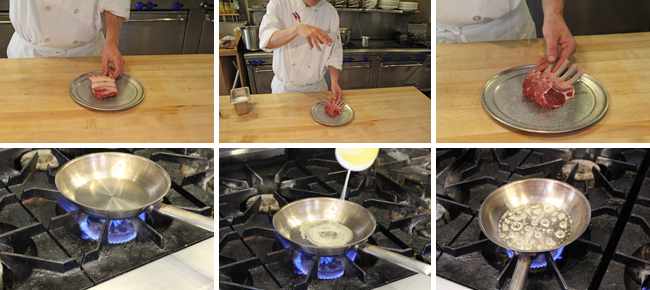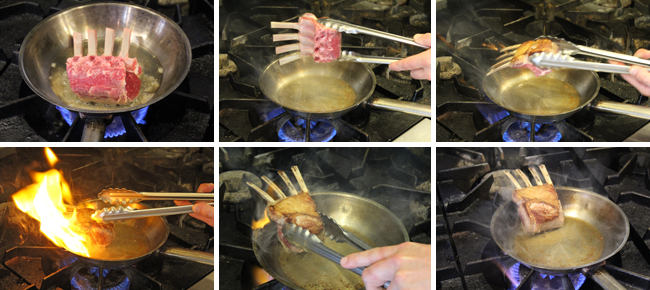Although there are numerous ways to cook a rack of lamb, one of my favorite methods is pan roasting. Pan roasting is the process in which you first sear your meat in a pan and then finish the "roasting process" in a hot oven. This is the most common method among professionals to cook most proteins, including poultry and fish.
Start by seasoning your rack of lamb liberally on both sides with kosher salt. Heat an appropriate sized, heavy bottom sauté pan over a high flame and add a high temp cooking oil once the pan heats up. Here we're using our standard 50/50 mix of canola oil and clarified butter.

Once the oil is hot, lay the rack of lamb gently in the pan with the bones facing away from you. This way, if any oil splashes out of the pan, the oil will move away from you, not back onto your hand.

Allow the lamb rack to brown on its back side for about 2-5 minutes depending on how powerful your burner is. Once it becomes a nice golden brown, flip the rack so that the bones rest away from you, leaning on the back edge of the pan, so the "top" of the loin has a chance to caramelize and brown. When you flip the lamb, it's possible that the pan will flame briefly. If it continues to flame, remove the pan from the burner and blow the flame out before continuing. A prolonged flame in your pan can give an "acrid" flavor to the product you're cooking, not to mention it's slightly dangerous, especially if you don't have a professional hood.

Allow the lamb to continue to sear for another 60 seconds and then place the pan, without changing the lamb's position, into a 450-500°F (230-260°C) oven. Roast in the oven for about 5-8 minutes or until mid-rare.

To check for proper doneness, squeeze the sides of the lamb between your middle finger and thumb. If the lamb still feels "squishy" and doesn't bounce back when squeezed then it's still fairly rare. If the lamb is firm and not "bouncy" when you squeeze it, then it's over cooked. If the lamb gives and bounces back immediately when squeezed then it's a perfect mid rare.
You can also take the lamb's internal temperature and remove it from the pan when you get a reading of 130ºF/55ºC, but what's the fun in that? You won't always have an instant probe thermometer when cooking, but you will always have your fingers (unless you have really bad knife skills and lop them off during prep, then I can't help you).
Once the desired finish temperature is reached, remove the lamb from the pan and allow it to rest for at least 5 minutes before slicing.

After the lamb has been allowed to rest, slice in half, cross the bones, and serve.

